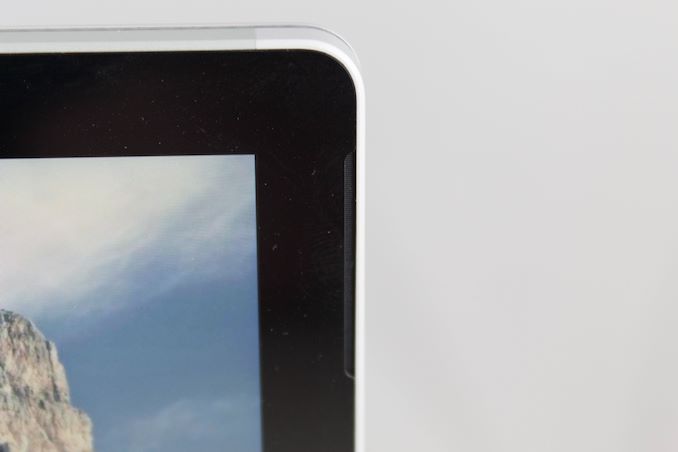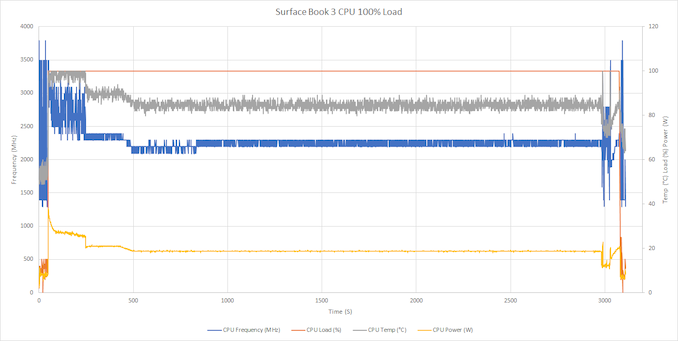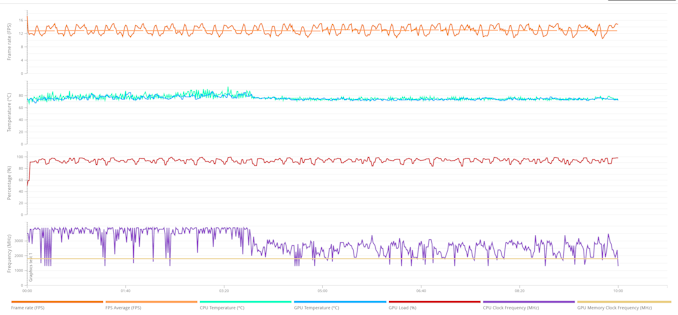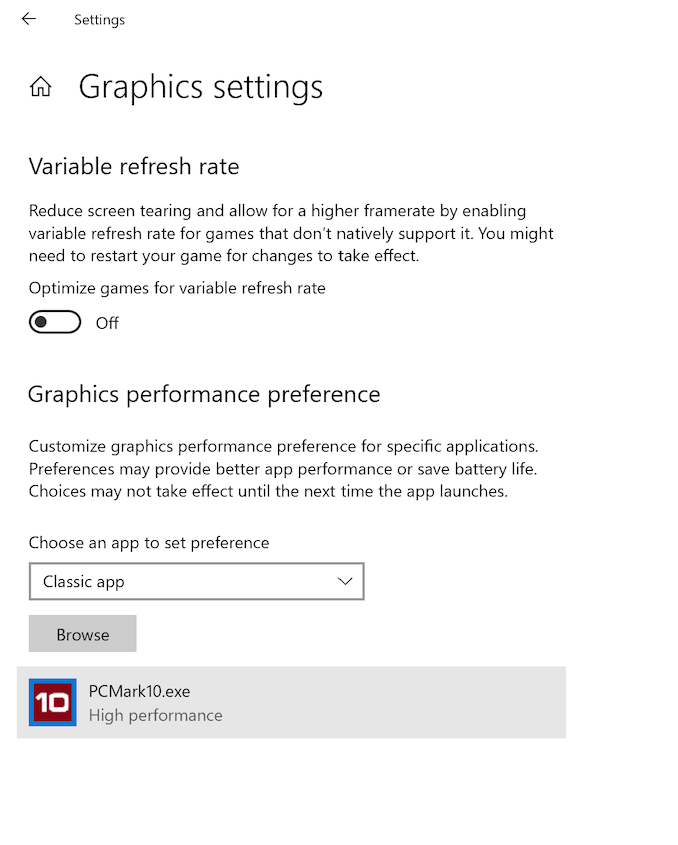The Microsoft Surface Book 3 (15-Inch) Review: A Refreshing Dip Into Ice Lake
by Brett Howse on June 3, 2020 9:00 AM ESTWireless
For the past several generations, Microsoft has leveraged Marvell networking adapters, unless the device had LTE, in which case they tended to use Qualcomm. Unfortunately, both were prone to unreliability and could not keep up with sustained transfer speeds like the latest Intel wireless solutions. Now that Wi-Fi 6 is upon us, the trend seems to be for everyone to use Intel wireless, including the Surface lineup. The Surface Book 3 features the Intel AX201 Wi-Fi 6 network adapter, which is a 2x2:2 design with the full 160 MHz channel width support.

The speeds are fantastic, and Intel has continued offering their very solid drivers too, so reliability has been top-notch. Although competition is always welcome, in the PC space there is really one standout wireless solution, and this is it.
Audio
Microsoft outfits the Surface Book 3 with front-facing stereo speakers featuring Dolby Atmos. As is typical of the Surface speakers, they blend almost seamlessly into the display bezel meaning they are almost invisible to the eye. There are also dual far-field microphones for dictation, or conferencing.
Sound quality of the speakers is excellent, and although they only achieved around 73dB(A) of SPL, the range of the speakers were quite impressive.
Thermals
The two-zone thermals of the Surface Book 3 mean that the temperature of the CPU will not impact the GPU, and vice versa. It also means that Microsoft has more room for a larger GPU, which we’ve seen the results of in our GPU testing. The CPU side with the Core i7-1065G7 has a thermal design of 15 Watts, meaning the processor is designed for a stead-state thermal load of 15 Watts, but with Intel’s aggressive Turbo, processors will draw much more than that for short bursts. On the GPU side, NVIDIA rates the GTX 1660 Ti Max-Q at between 65 and 80 Watts, depending on implementation.
The Surface Book 3 was subjected to a full CPU stress test, while monitoring the frequency and power draw of the processor. Interestingly, the processor very quickly bumps into the 100°C thermal limit, causing the processor to throttle at the start of the test during the PL1 stage of the CPU, which peaks at about 38 Watts maximum and 100°C. When PL1 ends and the processor moves into PL2, the power draw drops to a steady state value of around 19 Watts. So the Surface Book 3 can easily handle the full TDP of the processor, but it does not quite have enough to handle the full limit Microsoft implemented for PL1. This likely means there is not enough heatsink mass to handle the initial burst, although there is enough dissipation to handle the processor under load. As a comparison point, the Surface Laptop 3 with the same processor managed about 43 Watts at PL1 and it never quite reached the 100°C thermal cut-off, and then had a steady state of over 20 Watts. The overall cooling system is unsurprisingly not quite as capable as a more traditional laptop design, at least for the processor.
On the GPU front the Surface Book 3 also performs quite well. Unfortunately, our normal data logging tool was unable to read the GTX 1660 Ti, so instead we ran 20 loops of the 3DMark Fire Strike stress test. The GPU temperatures peaked at around 85° and settled in around 75°, with consistent FPS throughout the 20 loops.
One of the most amazing things about the Surface Book 3 thermals is how much performance there is considering the noise level. At full load after over an hour of use, the Surface Book 3 registered at only 43 dB(A) measured one inch over the trackpad. The tone of the noise is also low enough that it is very easy to live with. Despite not being able to get peak performance out of the CPU for a short window, the cooling system still does a great job and without much noise at all.
Software
One of the best perks of the Surface lineup is that there is no extra software installed to deal with, unless you include the unfortunate fluff that has started shipping directly in Windows. But as Surface is Microsoft’s device lineup, the Surface team also tends to bring new tech to Windows. For the Surface Laptop 3, that is the ability to choose the graphics adapter for each program directly in the Windows Settings. Previously, the NVIDIA Control Panel was required.
Branding of classic applications and UWP applications aside, it is nice to see this brought into Settings since it would be available for all GPU vendors and not require a proprietary tool.
Microsoft also includes the Surface App where you can see details about your device, battery levels of connected Surface peripherals, and get support.
Most laptops ship with some sort of tool for this function now, but the Surface one definitely has more polish than most.















125 Comments
View All Comments
Aisalem - Wednesday, June 3, 2020 - link
Did you ever try to use Surface Book outdoors?I can only say that as soon as the temp is over 90F (around 30C) my Book 2 will overheat and lock CPU at 800MHz, it's simply piece of junk at that time.
As much as I like it when used in cold office I will never buy another MS product due to that and also luck of proper servicing.
damianrobertjones - Wednesday, June 3, 2020 - link
Good luck with any oem as they've ALL had issues at one point in time.kenjiwing - Wednesday, June 3, 2020 - link
Does anyone know if the surface book 3 can drive two 4k displays at 60hz? The 2 could not because it used the internal intel chip instead of the nvidia one for external displays.timecop1818 - Wednesday, June 3, 2020 - link
i7-1065G7 supports DisplayPort 1.4, so theoretically with a type-c to dual displayport converter/MST hub you should be able to do 2x 4K@60. See https://dancharblog.wordpress.com/2019/10/10/dual-... for required bits.kenjiwing - Wednesday, June 3, 2020 - link
Thank you!FXi - Wednesday, June 3, 2020 - link
Just be wary because the SB2 cannot drive any external display using the 1060 GPU. Since that was not listed as an improvement of the SB3 you'll want to check carefully. You may be fine using the integrated Intel GPU to drive 2 4K displays or you may not. But no one reviewing has yet checked to see if the 1660 can drive any external connector (USB C or via the dock).kenjiwing - Thursday, June 4, 2020 - link
Well shitdamianrobertjones - Wednesday, June 3, 2020 - link
A full SD card slot would have been AMAZING! (Well... better, at least).amb9800 - Wednesday, June 3, 2020 - link
It has a full-sized SD card slot...ikjadoon - Wednesday, June 3, 2020 - link
Surface Book 3 (Anandtech, 2020):"Although the Surface Book 3 can ship with the fastest SSD Microsoft has ever put in a notebook, that was not the case for the review unit, which was actually slower than the 256 GB SSD in the Surface Laptop 3."
Surface Book (Anandtech, 2015):
"On a premium device like the Surface Book, I would expect only the best, and while the drive may meet their internal performance levels, a cacheless TLC based SSD in a premium device is not necessary."
Storage really cannot be that complex a decision. There are, at most, 5-6 OEM SSDs used on high-end premium notebooks.
Glad to see platform & internal improvements and a big thank you to Microsoft for outfitting these with at least decent webcams. For the price, though:
-- no TB3 is a sore spot (Microsoft Docks are obscenely priced and come with no smaller options...not to mention how buggy they have been)
-- a *single* USB type-C port is egregious in a premium 2020 15" notebook
-- that slow charging is painful for this "executives on the move" niche market (0-80% in an hour: curious they give the one-hour charging speed instead of 30 minutes...)
Are these nitpicks? Sure. But for a device that claims to "serve the high-end market", Microsoft continuously fails to read the room in a few crucial ways.
What else can do you, besides pity Panos Panay's Steve Jobs routine?